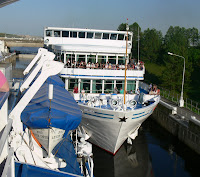Goritzy
Some time after leaving Yaroslavl we came to last of the locks on the Volga River but this time instead of going down in the lock to sail out water was flooded in and the boat rose around ten metres. Sailing out of the lock, on a point of land before entering a lake, was the statue of Mother Volga.
locks on the Volga River but this time instead of going down in the lock to sail out water was flooded in and the boat rose around ten metres. Sailing out of the lock, on a point of land before entering a lake, was the statue of Mother Volga.
During the night we entered the 
Goritzy is a small village with a population of around 1300, however, it is visited by many holiday cruise ships whose passengers make the 7km journey by bus to the Kirillov-Belozersky Russian Orthodox Monastery on the shore of the
There are two religious establishments in the area, the Kirillov-Belozersky monastery and the Goritzy nunnery, both of which have  powerful historical associations with Ivan the Terrible. The Kirillov-Belozersky monastery features at both the beginning and end of Ivan's life. Before he was born, his parents prayed here for God to give them an heir. Then when Ivan was an old sick man dying in agony he begged the monks here to pray for God to forgive him his bloody deeds. Apparently the monks believed that the terrible Tsar had changed and were even waiting for him to become a monk, but it never happened!
powerful historical associations with Ivan the Terrible. The Kirillov-Belozersky monastery features at both the beginning and end of Ivan's life. Before he was born, his parents prayed here for God to give them an heir. Then when Ivan was an old sick man dying in agony he begged the monks here to pray for God to forgive him his bloody deeds. Apparently the monks believed that the terrible Tsar had changed and were even waiting for him to become a monk, but it never happened!
The Kirillov-Belozersky monastery dates back to 1397 when monk called the Kirill (Cyril) who came from a wealthy family, decided to leave the easy life in Moscow as a result of a vision and look for a remote place where he could become closer to God and he originally built a wooden church on the site of the monastery.
The new monastery prospered and in the 16th century, it was the largest monastery and the second richest landowner in
Peter the Great also visited the monastery but not for religious purposes, taking away its bells for the metal to make canons to fight the Swedes and also forcing the young Monks into the army and navy.
The nearby nunnery was founded in 1554 by Princess Efrosiniya, the wife of one of Ivan the Terrible's sons. Unfortunately, she became one of Ivan's numerous victims, when Ivan began to suspect her and her son of treason, and the tsar had her cruelly drowned in the river Shekna. Worse was to follow, when Ivan turned the monastery into his own personal harem, his first and fourth wives were also exiled here. 
After a short visit to such an interesting place we returned to the ship which sailed at


No comments:
Post a Comment